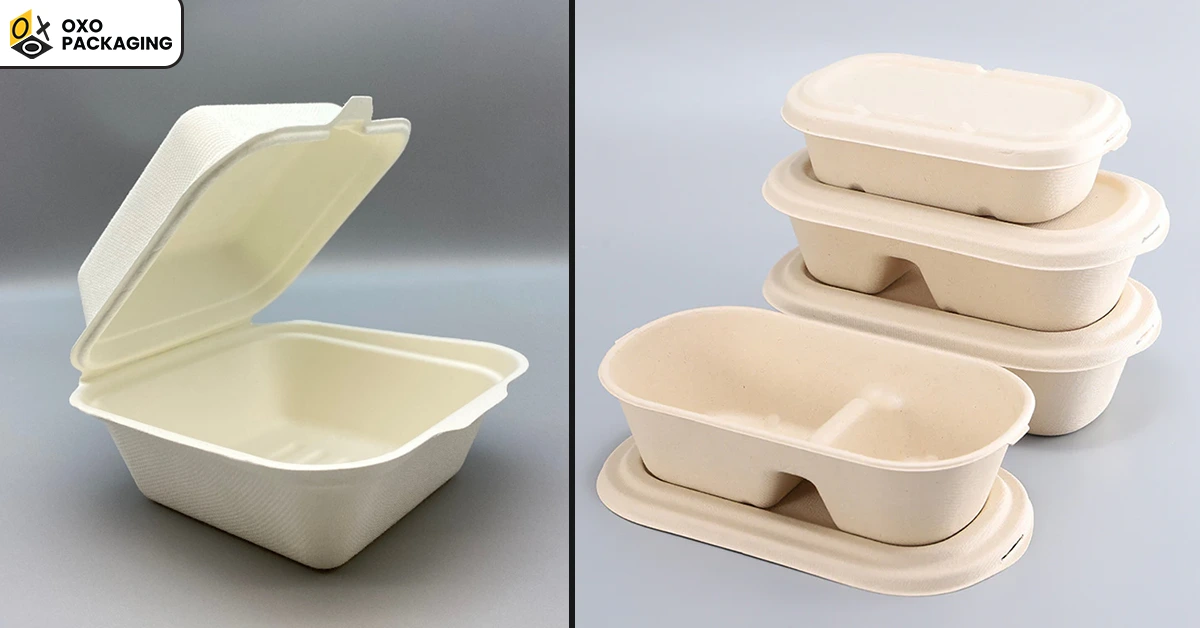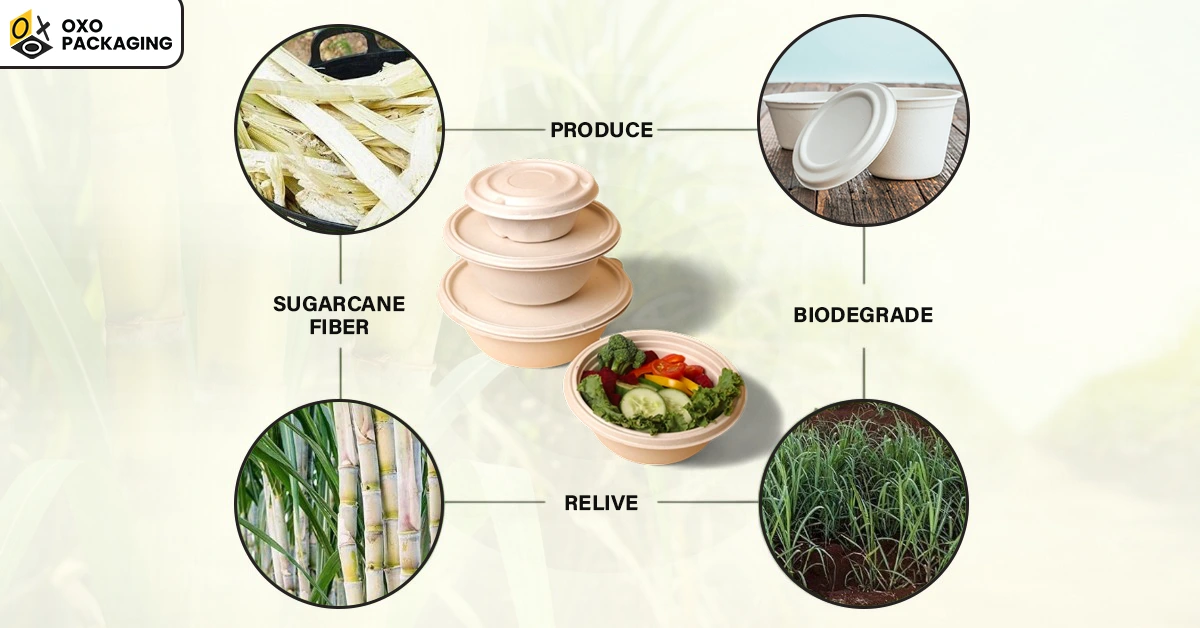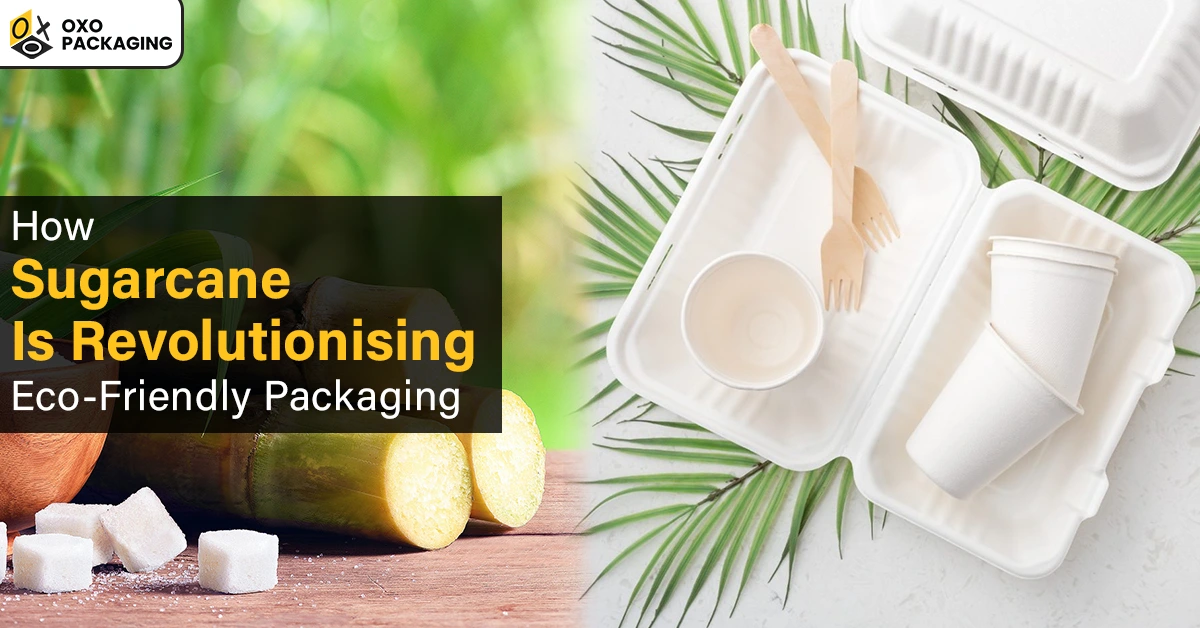The modern world is facing serious environmental repercussions due to excessive plastic waste accumulation. When it comes to the packaging industry, multiple businesses are seeking sustainable alternatives to conventional plastic packaging to promote green credentials.
One such solution is sugarcane packaging that’s gaining momentum among eco-conscious individuals and businesses. It is literally the humble agricultural byproduct revolutionising eco-friendly packaging. Let’s dive into its details!
What is Sugarcane Packaging?
Sugarcane is also called bagasse, which is a byproduct derived from sugar. Bagasse crops are fast-growing and are considered a highly renewable resource. Sugarcane stalks are harvested and pressed, while fibrous pulp is moulded into a paper-like substance, which is called bagasse. As a result, the containers made from the fibrous residue of sugarcane stalks after juice has been extracted are called “Bagasse Containers.”

What Makes Sugarcane Containers a Great Eco-Friendly Alternative?
Sugarcane or bagasse containers are becoming a popular eco-friendly packaging material owing to their renewable nature. They are emerging as a strong, sustainable alternative to conventional plastics or polystyrene.
Bagasse containers benefit the environment because they are biodegradable and compostable. That means they break down naturally within a few months in nature and soil. So, industries across various sectors are embracing sugarcane packaging for its versatility and sustainability benefits.
Benefits of Sugarcane Containers
Apart from being environmentally friendly, sugarcane containers have several benefits. Consider these benefits to make the best use of them for your business:
-
Grease and Water Resistance
Bagasse fibers naturally resist grease and oils, preventing leaks and keeping the container's structural integrity intact. Bagasse containers also contain good water resistance. It means they can hold liquids and prevent them from soaking through, even with high-moisture foods.
-
Durable and Lightweight
Derived from sugarcane waste, bagasse is naturally lightweight, making it easy to handle and transport. Despite their lightness, bagasse containers are strong and resistant to breaking or tearing, especially when compared to materials like Styrofoam.
-
Compostable and Biodegradable
Bagasse decomposes naturally through the action of microorganisms, returning to the environment without leaving harmful residues. Bagasse can be composted, meaning it breaks down into nutrient-rich organic matter that can be used to improve soil quality.
How Sugarcane is Revolutionising the Packaging Industry?
Sugarcane is repurposed to create robust, compostable containers as a sustainable alternative to traditional plastics. They are biodegradable and can be composted to minimise the environmental impact while reducing dependence on non-renewable resources. Have a look at what factors make sugarcane revolutionise the packaging industry:
-
Repurpose Sugar Waste
Bagasse is a byproduct of sugarcane processing, which was considered waste before. But after repurposing, it is no longer considered waste and becomes a valuable raw material to create a range of packaging products.
-
Originate From Renewable Resources
Since sugarcane is a rapidly renewable crop, unlike trees. Its fast growth cycle allows for a continuous supply of bagasse annually. This fastest cycle makes Bagaase a sustainable and eco-friendly alternative to petroleum-based plastics.
-
Promote Environmental Sustainability
Bagasse products are naturally biodegradable and compostable in nature. They break down within a relatively short timeframe while enriching the soil. The natural disintegration of bagasse products reduces plastic waste accumulation in landfills and oceans.
-
Minimise Carbon Footprint
The production of sugarcane packaging generally needs less energy and water compared to conventional plastics, while contributing to a lower carbon footprint. Bagasse also acts as a substitute for wood in paper production while reducing the demand for conservation resources.
-
Offer Versatile Applications
Sugarcane bagasse has versatility in terms of packaging forms. They can be molded into plates, bowls, clamshell containers, and trays. All these materials are suitable for presenting and packaging both hot and cold food items.
-
Offer Heat Resistance
Bagasse containers are generally heat-resistant and suitable for holding hot food. They can withstand temperatures up to 200°F or 93°C. Hence, you can confidently heat them in the microwave. This capability makes these containers ideal for a wide range of food service applications.
-
Reduce Landfill Waste
By breaking down naturally, bagasse containers don't contribute to the ever-growing problem of landfill waste. As bagasse doesn’t end up in landfills, waste accumulation is reduced. So, it minimises methane emissions, which are a potent greenhouse gas.
-
Support Circular Economy
Since sugarcane bagasse containers can be composted, they are used to enrich the soil. It ultimately contributes to a closed-loop system where natural resources are utilized efficiently without compromising durability and usability.
Explore Types of Bagasse Containers
Bagasse containers come in multiple types, each serving a unique purpose and showing distinctive properties. The two main types of these containers are:
-
Takeout Containers
They have either square or rectangular-shaped containers. They are specially designed for packaging food items for leftovers, delivery, and takeout. Takeout containers prevent spills and maintain food freshness with airtight lid closures during carrying and shipping.
-
Clam Shell Containers
These containers are also called hinged lid containers. They have a clamshell design with an attached lid. This thoughtful design allows easy opening and closing. Clamshell containers are commonly used for hot and cold foods, including salads, sandwiches, etc.
How are Sugarcane Containers Manufactured?
Bagasse containers are manufactured through a process that utilizes the fibrous residue left after sugarcane stalks are crushed to extract juice. This residue is known as bagasse. Then, bagasse is processed into a pulp, molded under heat and pressure, and eventually dried to create durable and compostable food packaging containers.

Why Should Brands Choose Sugarcane Containers?
There are plenty of reasons brands should opt for sugarcane packaging, not just to meet eco-friendly practices and satisfy eco-conscious customers. Let’s have a look at why businesses should invest in bagasse containers:
-
Evolving Market Trends
Customers are increasingly preferring businesses that are implementing environmentally friendly practices due to the growing global emphasis on sustainability. Your business can meet their expectations by adopting sugarcane containers.
-
Save Significant Cost
As a matter of fact, early investment in sustainable packaging options like sugarcane containers might cost you more. However, they ultimately lead to cost savings in the long run through enhanced customer engagement and retention rates.
-
Gain a Competitive Edge
Customers are more likely to support and promote brands that practice green packaging. So, take advantage of sugarcane containers to significantly enhance your brand image and gain a competitive edge, especially in the food industry.
Conclusion
Investing in sugarcane containers is more than adopting a new type of packaging. It’s more about establishing a base for your brand’s future and the health of the mother planet. By incorporating bagasse packaging, your brand supports environmental conservation while aligning with modern customer values and market trends. Contact OXO Packaging to get more innovative, sustainable packaging solutions like sugarcane packaging.
It’s crafted from bagasse—the fibrous pulp left after sugarcane juice extraction—processed into biodegradable containers, trays, and cups
Yes—it's compostable, biodegradable in 60–90 days under industrial conditions, carbon-negative, and made from renewable agricultural by-products
Despite being compostable, bagasse is durable—resistant to heat, moisture, grease, and physical stress—making it reliable for food service and packaged goods
Popular across foodservice (clamshells, trays), retail, e-commerce, cosmetics, electronics, and even seedling/pallet solutions
Yes—it biodegrades in 60–90 days in compost facilities and enriches soil with nutrients, supporting a circular waste model
It cuts CO₂ emissions, minimizes reliance on virgin materials, enhances sustainability credentials, and meets eco-conscious consumer demand
Expect advanced barrier coatings, smart applications, broader usage across industries, and market expansion projected through 2035

